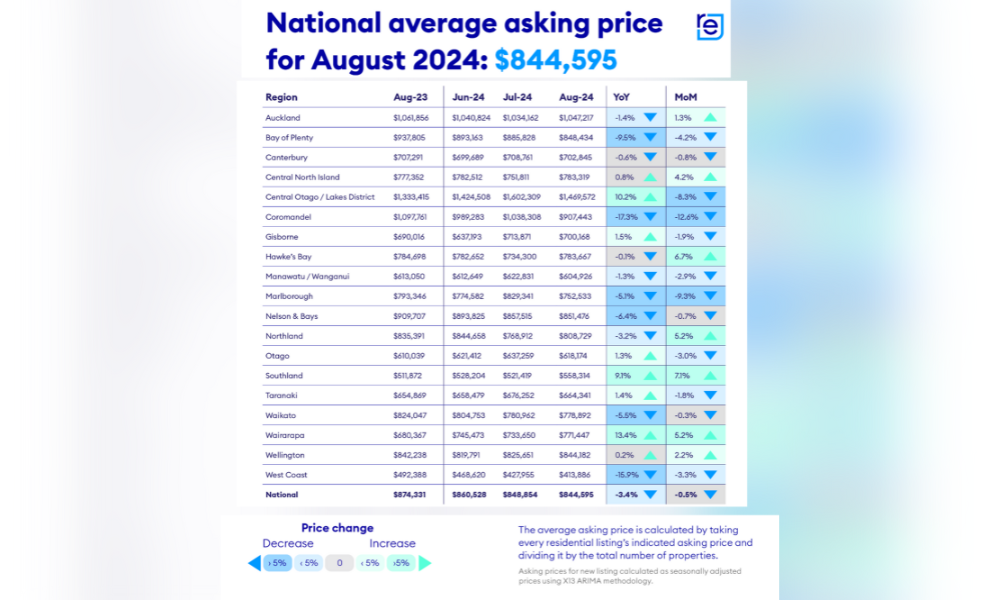New data reveals the latest on enquiries

The property market appears to be stirring after the Official Cash Rate (OCR) was reduced in August for the first time in four years.
Fresh data from realestate.co.nz reveals a notable increase in buyer engagement shortly after the OCR cut, suggesting that the market is already adjusting.
In the two weeks following the announcement, buyer activity rose noticeably: residential listing enquiries climbed by 8.5%, saved properties increased by 5.5%, and searches set to notify users of new listings went up by 6.2%.
Buyer interest on the rise
Sarah Wood (pictured above), CEO of realestate.co.nz, believes many potential buyers have been waiting for an opportune time to re-enter the market.
She noted: “Kiwis have a love affair with property, and while economic factors can sometimes dampen that enthusiasm, it never truly fades. We’ve heard that people have been waiting in the wings, and our data supports that.”
Wood suggests that the present market conditions offer a good opportunity for both buyers and sellers: “Those selling can capitalise on increased buyer interest, while those looking to buy still have plenty of choice. Both buyers and sellers can benefit from the relative stability in prices.”
The national average asking price dipped to $844,595 in August, the lowest in three and a half years. However, this represents just a 0.5% decline from July and a 3.4% drop from the previous year.
“This is not a significant dip. Prices remain stable around the mid $800,000 mark, continuing the flat trend observed over the past 18 months,” added Wood.
Vendor confidence returns
August saw an 8.1% increase in new property listings compared to the same time last year, reflecting a return to the seasonal trends typically expected in the market.
Wood explained: “Historically, the market has seen a steady rise in new listings during August, but this pattern has been notably absent since 2020. The return of this seasonal trend could indicate that we are entering a new phase of the cycle.”
The majority of regions—16 out of 19—experienced an uptick in new listings in August. The exceptions were Nelson & Bays, Northland, and Coromandel, which saw declines of 18.1%, 11.1%, and 5.9%, respectively.
“The rise in new listings suggests that vendors view this as a favourable time to sell, likely in response to a more positive sentiment in the market and increased buyer activity,” said Wood.
Easing stock levels may signal market shift
Nationally, stock levels were up by 30% year-on-year in August, reflecting the increase in new listings.
However, the number of homes available dipped below 30,000 for the first time in six months, signalling a potential shift.
“This slight softening in stock levels could signal increased market activity, as declining interest rates and the OCR announcement boost buyer confidence,” said Wood.
The number of properties listed on the website for less than 30 days also saw an 11.6% increase compared to July, indicating that homes are moving through the market more swiftly.
Wood noted that while there’s still plenty of stock to keep the market stable, these could be early signs of a change ahead.
Eighteen out of 19 regions saw double-digit stock growth year-on-year, with the Bay of Plenty being the only exception, where stock levels remained almost unchanged with a mere 0.7% increase.

Regional price variations and new peaks
In August, the national average asking price saw a slight decrease of 0.5% from the previous month and 3.4% compared to the same period last year. However, Southland defied this downward trend, setting a new record by surpassing the $550,000 mark for the first time, with an average asking price of $558,314—an all-time high in 17 years.
Southland, along with Wairarapa, was one of the few regions to experience price growth both month-on-month (up 7.1%) and year-on-year (up 9.1%). Wairarapa also saw a 5.2% rise from July and a substantial 14.4% increase compared to August last year.
Conversely, regions like Bay of Plenty, Coromandel, Manawatu/Whanganui, Marlborough, and West Coast all reported declines in their average asking prices both month-on-month and year-on-year.
Auckland showed a minor month-on-month increase in its average asking price for the first time since April.
This could signal a shift in market dynamics for the City of Sails, but Wood warns it is too early to say for sure: “Every region is unique, so it’s crucial to research the area you’re buying or selling in,” she said.
As the market responds to recent economic shifts, both buyers and sellers will need to stay informed and agile to navigate these changing conditions effectively.



